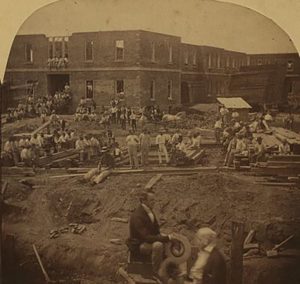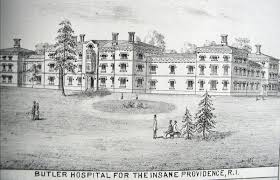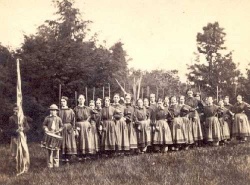
New Pennsylvania Hospital for the Insane Under Construction, circa 1859, courtesy Library of Congress
Just the word “asylum” conjures up negative associations for most people–we have learned so much about the conditions and abuses in these institutions that it is hard to believe anyone thought they could be a good idea. We may understand that this deterioration was never anticipated by the original asylum advocates, but we still ask the question: couldn’t they have guessed what would happen?
Perhaps not. Here is a description of a lunatic’s dwelling in Little Compton, Rhode Island circa 1845: “The place, when closed, had no source of light or of ventilation. It was about seven feet by seven, and six and a half high. All, even the roof, was of stone. An iron frame interlaced with rope, was the sole furniture. The place was filthy, damp, and noisome.
“. . . –there he stood [the insane man] near the door . . . his tangled hair fell about his shoulders; his bare feet pressed the filthy, wet stone floor; he was emaciated to a shadow. . . . In moving a little forward I struck against something which returned a sharp metallic sound; it was a length of ox-chain, connected to an iron ring which encircled a leg of the insane man.”

Seated Portrait of Dorothea Dix, circa 1849
The writer, Dorothea Dix, discovered that the man had been in this little cell for three years, with no heat in the winter. Before that, he was kept in a cage. Dix’s outrage and compassion for the unfortunate men and women held in these conditions spurred her life’s work of urging states to build asylums with decent conditions and amenities.

One Result of Dix’s Concern Was the Butler Hospital
When Dix saw the day-and-night difference in new asylums and the type of private care she described above, she undoubtedly believed that conditions could never be so bad in an institution as they had been under the haphazard system that spurred her reforms. And though asylum conditions did go downhill, they were never tolerated by society at large the way earlier abuses had been.


